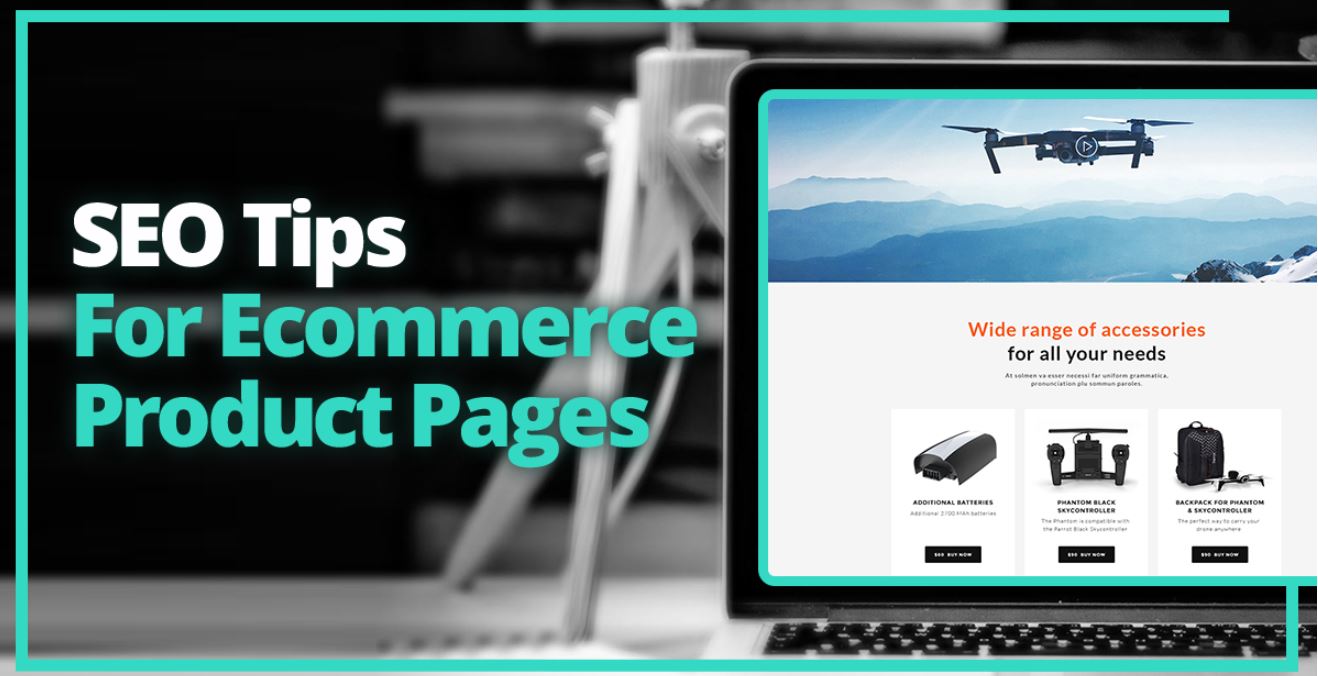SEO Tips For Ecommerce product pages

6 August 2020 Blog Posts
The ideal product page layout and optimisation varies from CMS platform to platform, as well as by industry and type of product. However, there are definitely some general best practice tips that apply in any case.Use this guide below when creating new product pages to ensure they are optimised, giving you and your business the best possible chance of ranking highly for specific product-based keywords.
Think about what people would search for or call the product when deciding on the URL. i.e. is the URL path relevant to the way people search online and how they refer to the product verbally? It’s always a good test to type the name in Google images and see what results/images come up. This is the best method to test product name vs. relevancy and what the market is looking for.
If possible, remove any automatically generated codes, arbitrary digits, or unnecessary tags as they do not serve any purpose to Google when crawling. Unnecessary characters increase the URL length, plus unnecessary folders only bury the product name further down the hierarchy, making it less important for Google to interpret.
Remove the URL category path for the products location where possible. It is always good practice to have a single product folder that will contain all products. We usually use a pattern of /product/product-name/, it is great for analytical and crawling purposes.
Lastly, do not use category or general names as product names, for example: black-dress-123 or mini-dress-brand etc unless of course that is the actual product’s name. Otherwise, these names will just compete with categories for the same search intent.
Example Product: Brand = “XYZ” —– Product = “Black Leather Handbag”
Optimised URLs:
www.frop.com.au/xyz-black-leather-handbag
www.frop.com.au/product/black-leather-handbag
Non-optimised URLs:
www.frop.com.au/shop/brand001-xyz-blk#handbag-?998
www.frop.com.au/brands/xyz/black-leather-handbag
These factors go for Metas as well. Make sure the meta title and meta description are engaging for real users and contain some keyword variance.
In particular, make sure to align the meta title with the best possible keyword. It should also contain the specific product variant or differentiating factor that applies to it.
Example H1: “XYZ Black Leather Handbag”
Example Meta Title: “XYZ Black Leather Handbag – Black XYZ Handbags Online”
Example Meta Description: “Looking to spruce up your look this Winter? Shop our latest Black Leather Handbag online from XYZ. If you love trusted brands like XYZ and need a new black leather handbag, shop today with free online shipping!”
Once again, think of questions people would ask or specs they would be looking for and add that information to your products. This not only helps to inform the user but also gives you a better chance of ranking featured snippets in SERPs.
Lastly, try not to just copy the manufacturer’s content if you do not have to. This is the easier approach, but it is not unique content if ten other suppliers are using it too, most sites will just copy it. Having unique content is one way to stand out and to show Google you have more valuable information to showcase, helping you move up the rankings.
Always keep in mind that people refer to the same thing differently, hence using different keywords to search for the same product. Make sure you use synonyms, antonyms, phrases and stories.
Crawlable and indexable reviews are also a great way of diversifying your product content, which can be further used for featured snippets and improve CTR.
There are some exceptions to this rule, as you’ll find some specs and ingredients searches will still come up with plain paragraph text snippets. However, what we’ve learned just recently from testing in Google, is that depending on the query, sometimes a table or list format is preferred and is what ultimately gets the featured snippet in position zero.
Aside from these simple tips for SEO, your product pages should generally be user-friendly and set up with conversion rate optimisation in mind for real users.
Having a competitive price, discount from RRP, multiple high-quality photos, great five-star reviews and an easy to find CTA or add to cart, will ALL come into play when it comes to optimising your product pages.
So, try these SEO basics first and check how your next few products rank over time. If you have questions, feel free to get in touch with the team here at Megantic.
URL format:
Keep the URL path neat with the product name separated by hyphens. Plus, include the product variant if it is something people would be searching for, such as: colour, size or material. NOTE: this is a good strategy if you decided to go on a single product path instead of configurable.Think about what people would search for or call the product when deciding on the URL. i.e. is the URL path relevant to the way people search online and how they refer to the product verbally? It’s always a good test to type the name in Google images and see what results/images come up. This is the best method to test product name vs. relevancy and what the market is looking for.
If possible, remove any automatically generated codes, arbitrary digits, or unnecessary tags as they do not serve any purpose to Google when crawling. Unnecessary characters increase the URL length, plus unnecessary folders only bury the product name further down the hierarchy, making it less important for Google to interpret.
Remove the URL category path for the products location where possible. It is always good practice to have a single product folder that will contain all products. We usually use a pattern of /product/product-name/, it is great for analytical and crawling purposes.
Lastly, do not use category or general names as product names, for example: black-dress-123 or mini-dress-brand etc unless of course that is the actual product’s name. Otherwise, these names will just compete with categories for the same search intent.
Example Product: Brand = “XYZ” —– Product = “Black Leather Handbag”
Optimised URLs:
www.frop.com.au/xyz-black-leather-handbag
www.frop.com.au/product/black-leather-handbag
Non-optimised URLs:
www.frop.com.au/shop/brand001-xyz-blk#handbag-?998
www.frop.com.au/brands/xyz/black-leather-handbag
Page Title/Metas & H1:
The H1 should align with the main, singular long-tail keyword you wish to target, which on a product page should be the full product name. Most importantly make sure it is unique from other H1s across your site, you do not want to have the same H1 or same search intent across multiple pages.These factors go for Metas as well. Make sure the meta title and meta description are engaging for real users and contain some keyword variance.
In particular, make sure to align the meta title with the best possible keyword. It should also contain the specific product variant or differentiating factor that applies to it.
Example H1: “XYZ Black Leather Handbag”
Example Meta Title: “XYZ Black Leather Handbag – Black XYZ Handbags Online”
Example Meta Description: “Looking to spruce up your look this Winter? Shop our latest Black Leather Handbag online from XYZ. If you love trusted brands like XYZ and need a new black leather handbag, shop today with free online shipping!”
Content:
Featuring a detailed and unique product description in HTML text format, is key when it comes to optimising product pages.Once again, think of questions people would ask or specs they would be looking for and add that information to your products. This not only helps to inform the user but also gives you a better chance of ranking featured snippets in SERPs.
Lastly, try not to just copy the manufacturer’s content if you do not have to. This is the easier approach, but it is not unique content if ten other suppliers are using it too, most sites will just copy it. Having unique content is one way to stand out and to show Google you have more valuable information to showcase, helping you move up the rankings.
Always keep in mind that people refer to the same thing differently, hence using different keywords to search for the same product. Make sure you use synonyms, antonyms, phrases and stories.
Crawlable and indexable reviews are also a great way of diversifying your product content, which can be further used for featured snippets and improve CTR.
Additional Tips:
It’s best to keep general product info and Q&As in plain text form (p), but try experimenting with putting information such as sizing, specs and ingredients in a table format (td class) or list format. Try embedding videos too if you have a Youtube channel showcasing products, as this can help with snippets too.There are some exceptions to this rule, as you’ll find some specs and ingredients searches will still come up with plain paragraph text snippets. However, what we’ve learned just recently from testing in Google, is that depending on the query, sometimes a table or list format is preferred and is what ultimately gets the featured snippet in position zero.
Aside from these simple tips for SEO, your product pages should generally be user-friendly and set up with conversion rate optimisation in mind for real users.
Having a competitive price, discount from RRP, multiple high-quality photos, great five-star reviews and an easy to find CTA or add to cart, will ALL come into play when it comes to optimising your product pages.
So, try these SEO basics first and check how your next few products rank over time. If you have questions, feel free to get in touch with the team here at Megantic.



